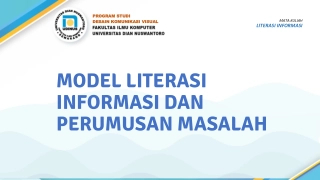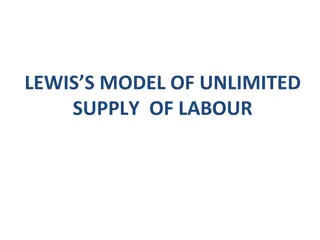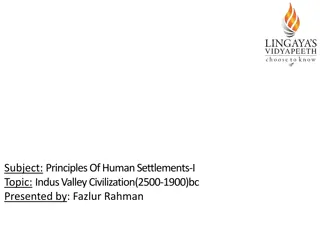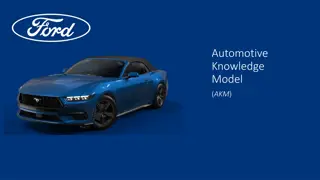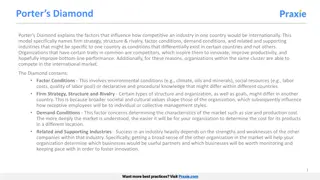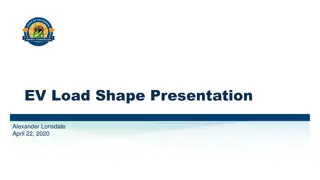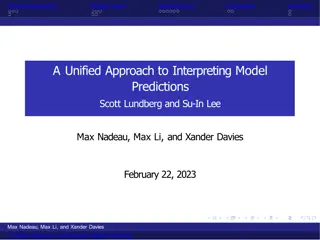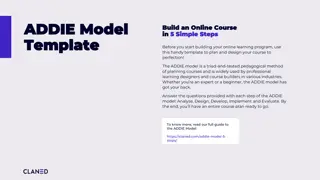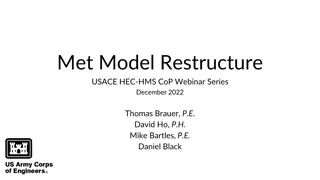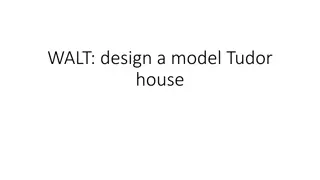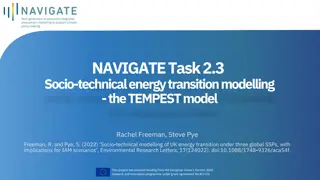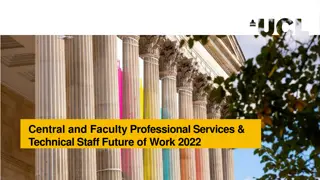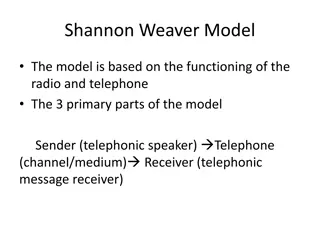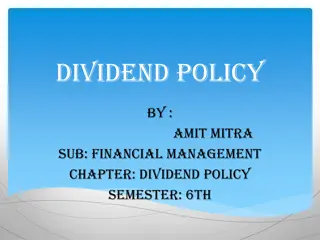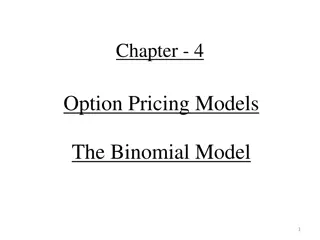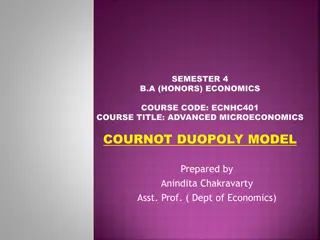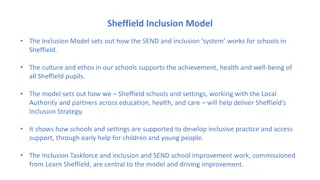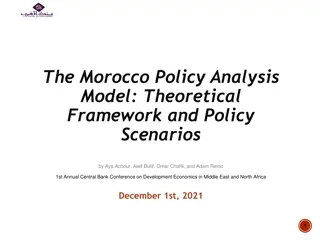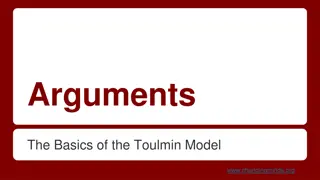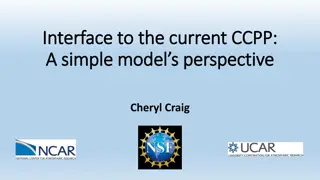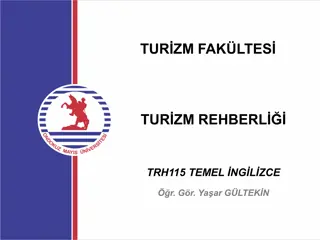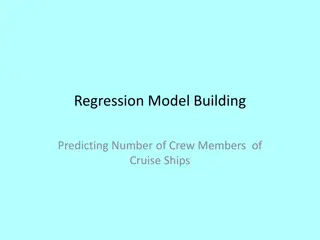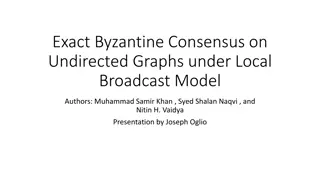Model Literasi Informasi dan Perumusan Masalah dalam Desain Komunikasi Visual
Materi ini membahas model literasi informasi, langkah-langkahnya, serta perumusan masalah dalam konteks Desain Komunikasi Visual. Mahasiswa akan mempelajari berbagai keterampilan dan langkah dalam mengolah informasi, merumuskan masalah, dan menentukan sudut pandang. Model-model literasi informasi se
0 views • 27 slides
Lewis Two-Sector Model: Sustaining Economic Growth Through Labor Transfer
Lewis Two-Sector Model, based on the assumption of surplus labor in agriculture, explains how transferring labor to the industrial sector boosts economic growth. The model highlights the shift from traditional to modern sectors, increased output, wages, and profits, and self-sustaining growth capabi
0 views • 10 slides
Building a Macrostructural Standalone Model for North Macedonia: Model Overview and Features
This project focuses on building a macrostructural standalone model for the economy of North Macedonia. The model layout includes a system overview, theory, functional forms, and features of the MFMSA_MKD. It covers various aspects such as the National Income Account, Fiscal Account, External Accoun
2 views • 23 slides
NAMI Family Support Group Model Overview
This content provides an insightful introduction to the NAMI family support group model, emphasizing the importance of having a structured model to guide facilitators and participants in achieving successful support group interactions. It highlights the need for a model to prevent negative group dyn
6 views • 23 slides
Urban Development Models: Burgess and Hoyt
The Burgess concentric ring model and Hoyt sector model are key frameworks explaining urban social structures. Burgess's model illustrates urban land use in rings around the CBD, while Hoyt's model emphasizes outward growth along transportation arteries. Criticisms include applicability limitations
5 views • 13 slides
Understanding Automotive Knowledge Model (AKM) for Automobiles
Automotive Knowledge Model (AKM) is an expressive and extensible vocabulary and data model that provides semantics and standards-based signals, metrics, DIDs, and DTCs for automobiles. This model includes sample signals like HVAC station temperature settings and features a comprehensive data structu
2 views • 29 slides
Understanding the Biopsychosocial Model of Healthcare: Insights from Dr. Caryl Sibbett
Exploring the biopsychosocial model of healthcare through the work of Dr. Caryl Sibbett at Kairos Consultancy in 2020. This model emphasizes the interconnected aspects of biology, psychology, and social factors in understanding and treating disease. It challenges the dominance of the biomedical mode
1 views • 18 slides
Porter's Diamond Model for International Competitiveness
Porter's Diamond model explains the factors influencing the competitiveness of an industry internationally, focusing on firm strategy, structure, and rivalry; factor conditions; demand conditions; and related and supporting industries specific to each country. These elements shape how organizations
0 views • 4 slides
Overview of EV Infrastructure Load Model (EVIL) by Alexander Lonsdale
The EVIL model, developed by ADM, provides hourly electricity load shapes for transportation in commercial and residential sectors. It uses R executable scripts and static outputs to drive model output, facilitating scenario building for utility rate structures and energy forecasts. The model functi
2 views • 23 slides
A Unified Approach to Interpreting Model Predictions
Unified methodology for interpreting model predictions through additive explanations and Shapley values. It discusses the relationship between Additive Explanations and LIME, introduces Shapley values, approximations, experiments, and extensions in model interpretation. The approach unifies various
1 views • 21 slides
Designing an Online Course Using ADDIE Model: 5 Simple Steps
Design your online course effectively using the ADDIE model in 5 simple steps. Analyze the course objectives, identify the target audience, address constraints, and plan content design to create a successful online learning program. Utilize the insights from the Analysis step to make crucial decisio
0 views • 11 slides
Restructuring of USACE HEC-HMS Meteorologic Model
Significant modifications have been made to the HEC-HMS meteorologic model to enhance modeling tasks' ease and intuitiveness. The Met Model Restructure updates in versions 4.9 to 4.11 streamline meteorologic processes, introduce new features like automatic linkages and zonal editors for snowmelt, an
0 views • 19 slides
Create a Model Tudor House: A Fun and Educational Activity
Explore the world of Tudor houses by designing and creating a model Tudor house using simple materials found at home. Follow the steps outlined to draw a design, gather materials, and construct your Tudor house model over a span of two days, with the freedom to tweak your design as you progress. Uti
0 views • 7 slides
Socio-technical Energy Transition Modelling: The TEMPEST Model
A simulation model, TEMPEST, incorporating societal and political factors, evaluates UK energy transition under three global SSPs. It analyzes the importance of political capital and societal preferences in adopting mitigation measures. The model's results are compared to the IMAGE model, suggesting
1 views • 5 slides
Understanding Health Risk Adjustment Models in Healthcare
This content discusses the DHA Risk Adjustment Model, its clinical conditions, and the utilization of risk scores in various populations. It outlines how Health Affairs sponsored the development of a tailored risk adjustment model for the Prime Population and provides examples of clinical conditions
0 views • 23 slides
UCL Staff Feedback on Hybrid Work Model Implementation
UCL conducted a survey among staff to gather feedback on the interim guidance for transitioning back to onsite work. The survey highlighted staff support for a hybrid work model, emphasizing productivity, efficiency, and well-being benefits. Staff also expressed a preference for clear expectations a
2 views • 21 slides
Understanding Entity-Relationship Model in Database Systems
This article explores the Entity-Relationship (ER) model in database systems, covering topics like database design, ER model components, entities, attributes, key attributes, composite attributes, and multivalued attributes. The ER model provides a high-level data model to define data elements and r
0 views • 25 slides
Communication Models Overview
The Shannon-Weaver Model is based on the functioning of radio and telephone, with key parts being sender, channel, and receiver. It involves steps like information source, transmitter, channel, receiver, and destination. The model faces technical, semantic, and effectiveness problems. The Linear Mod
0 views • 8 slides
Understanding Dividend Policy in Financial Management
Dividend policy in financial management involves decisions regarding the distribution of earnings to shareholders and retained earnings. It includes types of dividends, time of payment, and dimensions impacting the policy. Various dividend theories like Modigliani and Miller's Model, Walter's Model,
0 views • 34 slides
Demographic Human Capital DGE Model for High-Growth Scenarios in Rwanda
This study focuses on a Demographic Human Capital Dynamic General Equilibrium (D-DGE) model for analyzing high-growth scenarios in Rwanda from 2016 to 2050. It explores the interactions of demographic dynamics, human capital, public infrastructure, and debt within a long-term growth framework. The m
0 views • 28 slides
Understanding Atomic Structure: Electrons, Energy Levels, and Historical Models
The atomic model describes how electrons occupy energy levels or shells in an atom. These energy levels have specific capacities for electrons. The electronic structure of an atom is represented by numbers indicating electron distribution. Over time, scientists have developed atomic models based on
0 views • 5 slides
Understanding OSI Model and TCP/IP Protocol Suite in Computer Networking
This chapter explores the OSI model and TCP/IP protocol suite, delving into protocol layers, addressing mechanisms, and network components. It highlights the interface between layers, functions of each layer in the OSI model, and compares TCP/IP protocol suite layers with OSI model layers. The discu
0 views • 30 slides
Understanding the Binomial Option Pricing Model
This chapter delves into the fundamental concept of option pricing models, specifically focusing on the Binomial Model. An option pricing model serves as a mathematical framework to calculate the fair value of an option based on certain inputs. The ultimate goal is to determine the theoretical fair
2 views • 38 slides
Understanding ROC Curves and Operating Points in Model Evaluation
In this informative content, Geoff Hulten discusses the significance of ROC curves and operating points in model evaluation. It emphasizes the importance of choosing the right model based on the costs of mistakes like in disease screening and spam filtering. The content explains how logistical regre
6 views • 11 slides
Understanding the Kinked Demand Curve Model in Oligopoly
The kinked demand curve model in oligopoly, developed by Paul M. Sweezy, highlights stability in pricing and output decisions among firms. This model suggests that rival firms may react asymmetrically to price changes, leading to a kink at a certain price level. Assumptions include few firms produci
3 views • 7 slides
Understanding the Cournot Duopoly Model in Advanced Microeconomics
The Cournot Duopoly Model, named after Augustin Cournot, is an economic model where competing firms independently choose quantities to produce simultaneously. It strikes a balance between monopoly and competition, resulting in stable Nash Equilibrium. While advantageous, it has limitations due to un
8 views • 5 slides
Sheffield Inclusion Model: Supporting Achievement and Well-being in Schools
The Sheffield Inclusion Model outlines how the SEND and inclusion system works in Sheffield schools, emphasizing the importance of supporting the achievement, health, and well-being of all pupils. Through collaborative efforts with the Local Authority and various partners, the model aims to deliver
1 views • 4 slides
Analysis of the Moroccan Policy Analysis Model for Economic Development
The Morocco Policy Analysis Model (MOPAM) is a large-scale annual model that incorporates fiscal and monetary policies, inspired by the IMF's FSGM model. It examines the impact of a flexible exchange rate regime and various fiscal policy stances on economic fundamentals. MOPAM features DSGE and OLG-
0 views • 15 slides
Understanding the OSI Model and Layered Tasks in Networking
The content highlights the OSI model and layered tasks in networking, explaining the functions of each layer in the OSI model such as Physical Layer, Data Link Layer, Network Layer, Transport Layer, Session Layer, Presentation Layer, and Application Layer. It also discusses the interaction between l
1 views • 41 slides
Regression Diagnostics for Model Evaluation
Regression diagnostics involve analyzing outlying observations, standardized residuals, model errors, and identifying influential cases to assess the quality of a regression model. This process helps in understanding the accuracy of the model predictions and identifying potential issues that may aff
1 views • 12 slides
Mastering Reported Speech: Simple Present to Simple Past
Learn how to convert statements from the simple present tense to the simple past tense in reported speech with clear examples. Practice exercises are provided for better understanding, covering various sentence structures including negative sentences and present continuous to past continuous transfo
0 views • 45 slides
Difference Between Manual Testing and Model Checking
Manual testing focuses on testing specific scenarios with concrete inputs and outputs, while model checking involves imagining all possible scenarios to create a general environment for testing. In manual testing, users test specific execution scenarios, whereas in model checking, users envision and
2 views • 4 slides
Understanding the Toulmin Model for Effective Argumentation
The Toulmin Model provides a structured approach to crafting and evaluating arguments, consisting of key components like claims, grounds/data, and warrants. It emphasizes the importance of using evidence and reasoning to support claims effectively. By understanding this model, one can enhance the pe
0 views • 13 slides
MFMSA_BIH Model Build Process Overview
This detailed process outlines the steps involved in preparing, building, and debugging a back-end programming model known as MFMSA_BIH. It covers activities such as data preparation, model building, equation estimation, assumption making, model compilation, and front-end adjustment. The iterative p
0 views • 10 slides
Understanding the Interface to the Current CCPP: A Simple Model's Perspective
This content explores the interface to the current CCPP from a simple model's viewpoint, focusing on two simplistic schemes - kinetics and chem_solve. It delves into how the MusicBox simple driver model adapts chemical species using temperature and rate constants. Users can control the run sequence
0 views • 9 slides
Proposal for Radio Controlled Model Aircraft Site Development
To establish a working relationship for the development of a site suitable for radio-controlled model aircraft use, the proposal suggests local land ownership with oversight from a responsible agency. Collins Model Aviators is proposed as the host club, offering site owner liability insurance throug
0 views • 20 slides
Understanding Simple Past Tense in English: Rules and Examples
The simple past tense is a fundamental form in Modern English used to describe past events. It involves regular verbs adding "-ed" and irregular verbs having different forms. The construction of the simple past helps distinguish it from other past tense forms like past perfect and past progressive.
0 views • 33 slides
UBU Performance Oversight Engagement Framework Overview
Providing an overview of the UBU Logic Model within the UBU Performance Oversight Engagement Framework, this session covers topics such as what a logic model is, best practice principles, getting started, components of the logic model, evidence & monitoring components, and next steps. The framework
0 views • 33 slides
Regression Model for Predicting Crew Size of Cruise Ships
A regression model was built to predict the number of crew members on cruise ships using potential predictor variables such as Age, Tonnage, Passenger Density, Cabins, and Length. The model showed high correlations among predictors, with Passengers and Cabins being particularly problematic. The full
0 views • 16 slides
Exact Byzantine Consensus on Undirected Graphs: Local Broadcast Model
This research focuses on achieving exact Byzantine consensus on undirected graphs under the local broadcast model, where communication is synchronous with known underlying graphs. The model reduces the power of Byzantine nodes and imposes connectivity requirements. The algorithm involves flooding va
0 views • 7 slides
